Without question, brakes are one of the most important components of a bike. Ask any aggressive rider what they want out of a brake, and the first thing most would say is tons of stopping power. Now ask SRAM what’s up with their new Maven brakes and they’ll say “Maven is the absolute most powerful brake we’ve ever made.”
The new Maven brakes have beefy 4-piston calipers, large caliper and lever pistons, a re-tuned lever, and new XL brake pads, all of which make them an incredibly strong brake. With all that power, riders can lighten up on squeezing their levers and reduce arm fatigue. Of course, sheer power is no good without the ability to control it, so the Mavens can be tuned in various ways to provide a lighter or more forceful bite.
SRAM has produced three different models of the new brakes. The Maven Ultimate, Silver, and Bronze. I’ve had the Maven Ultimates on my bike since early this month, so my initial impressions are included in this post. I plan to write a full review later this summer after a lot more testing and tuning.
SRAM Maven Brakes:

Let’s start with some numbers. Most importantly, SRAM says the Mavens produce almost 50% more power than their DH-grade Code brakes. They also say it takes 32% less force at the lever to match the bite power of Codes. With gobs of power, the Maven brakes are suitable for any type of riding; DH, eMTB, enduro, or trail.
In the Maven’s press material, SRAM dove deep into explaining how heat management provides optimal braking power and control. I’ll describe below how some of the Mavens’ components help achieve this…
Calipers:
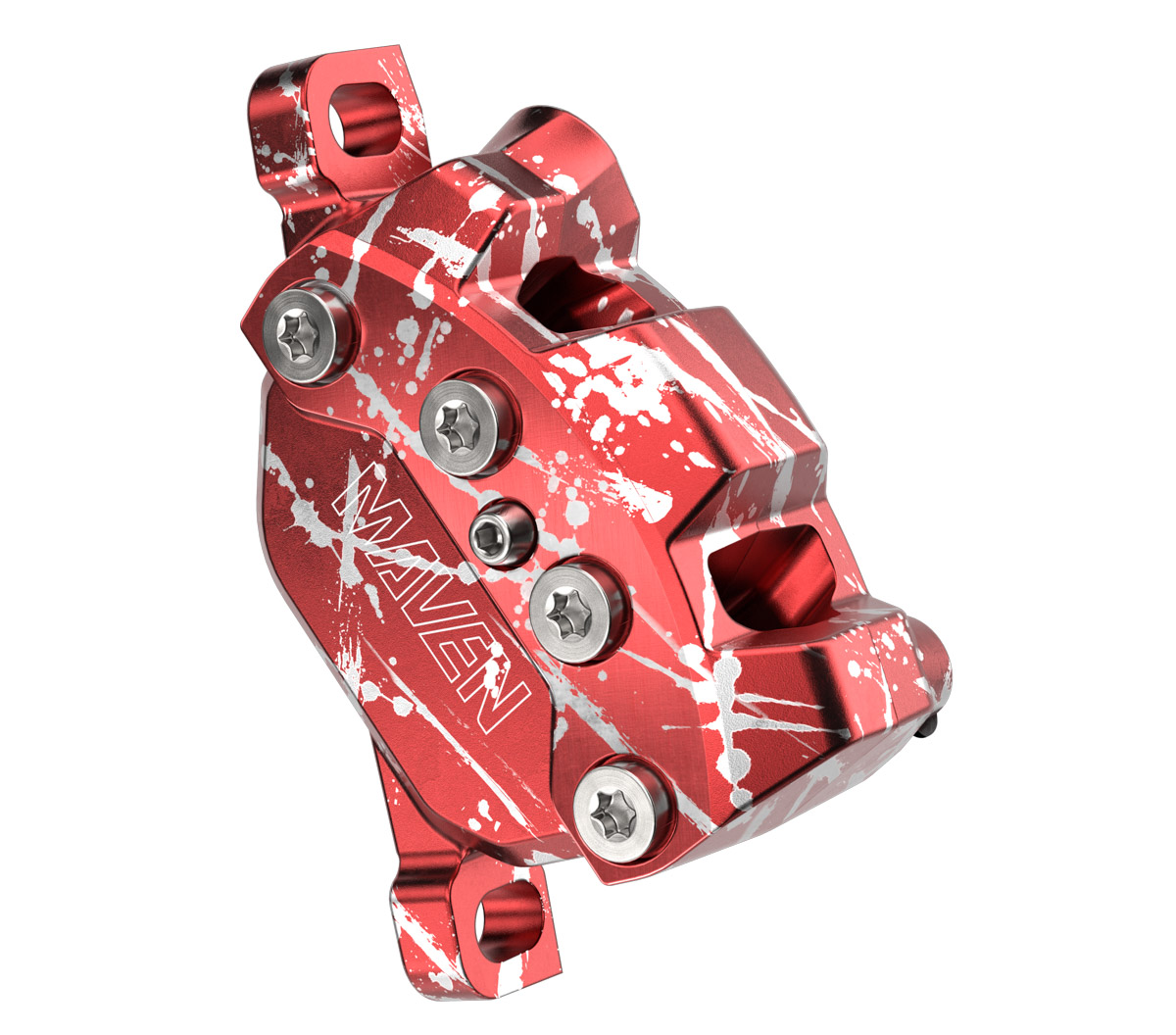
The Maven calipers are quite beefy looking, and those four big bolts are there for strength! They keep the caliper body extra stiff, reducing flex and power losses. All models of the calipers use large pistons, with two 18mm and two 19.5mm in each. The big pistons offer more surface area to push on the new XL pads the Mavens require. The Mavens’ brake pads are bottom-loading.
As for managing heat, the Maven calipers are actually designed not to cool down too quickly. The calipers do take longer to heat up, but once they do they will resist overheating and stay within an optimal temperature range longer than other brakes. SRAM says less temperature variation as you ride translates into more consistent braking power.
Maven is Mineral Oil-Based

Surprisingly, the Maven is a mineral oil system. A few years ago, SRAM built two versions of the same brake system and tested them back-to-back with both mineral oil and DOT brake fluid. They liked some of the advantages of mineral oil, particularly a longer-lasting setup with less maintenance. However, they had to overcome one issue: the seals in the calipers.
Traditional mineral oil-compatible seals simply don’t perform as well as those designed for DOT brake fluid. The oil-resistant material they use doesn’t handle extreme temperature variations as well as DOT-compatible seals. To resolve this SRAM found a new proprietary seal material that’s mineral oil-friendly, but can handle high-heat situations and low temperatures.
On the topic of mineral oil, SRAM only approves the use of Maxima Mineral Brake Oil (co-developed with SRAM) for the Maven brakes.
Levers:
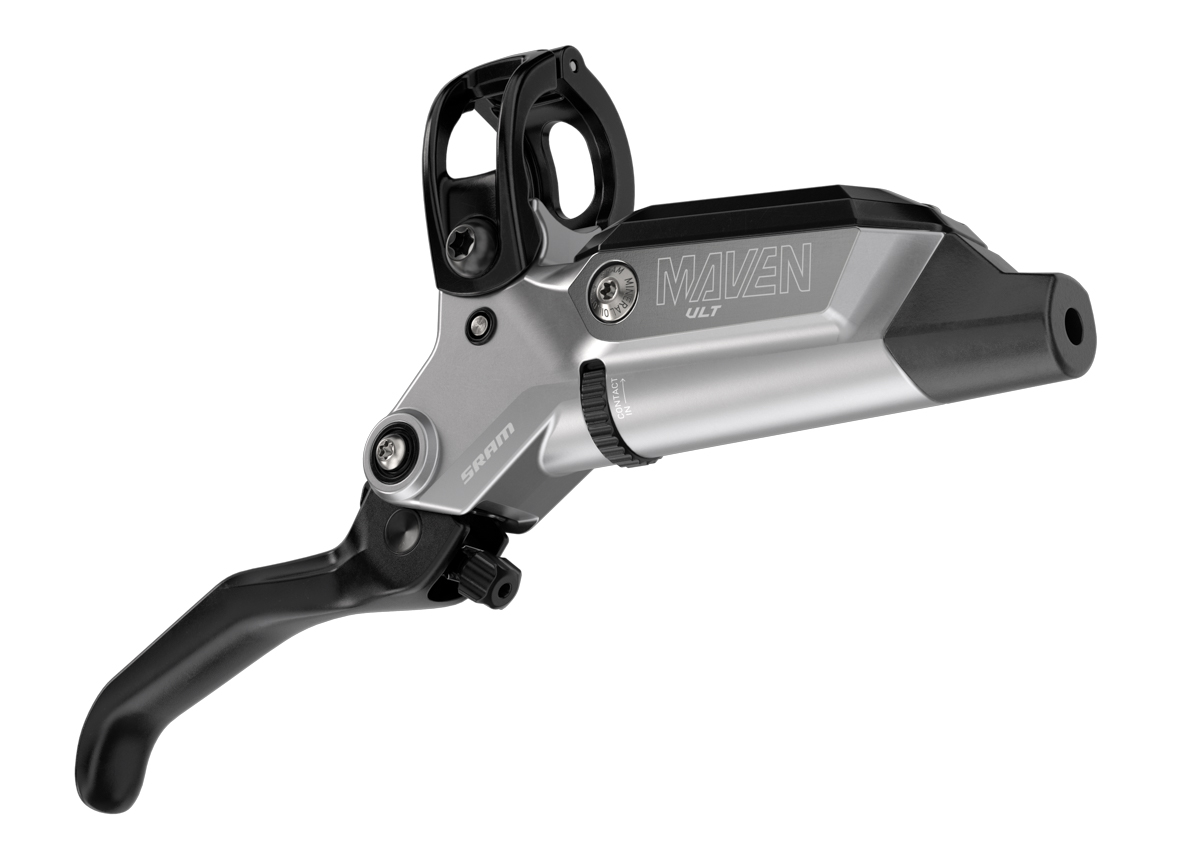
The Maven brake levers offer a similar feel to SRAM’s Code levers. They feature the same pivot point, blade shape, tool-free reach adjusters, and (on most models) contact point adjustments. I like how close the lever body sits to your handlebar. It’s not a tiny lever, but SRAM tucks it in nicely so it doesn’t look too bulky. The Maven levers were designed with SRAM’s ‘stealth architecture’ so they do have a fairly sleek appearance for their size.

SRAM has re-tuned their SwingLink lever and optimized it for the Mavens. The lever’s leverage rate changes through the stroke, delivering more power the further you pull. The intention is to provide more progressive power delivery and prevent an ‘on/off’ feeling.
SRAM ensured to match the big caliper pistons with an appropriately sized lever piston. They say the ratio between the two must be balanced to provide maximum stopping power.
Rotors:
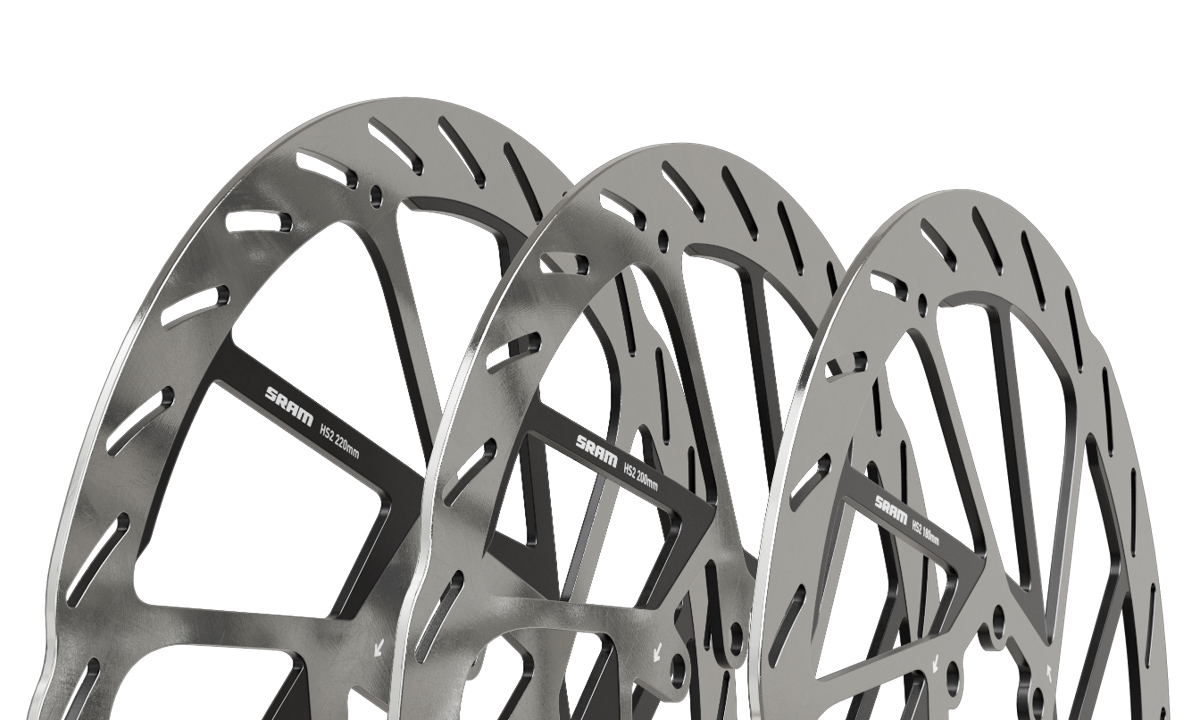
The new Mavens do not require specific rotors. SRAM recommends using their HS2 rotors for the most stopping power and best heat management, or their Centerline rotors if you’d rather shave some weight and don’t mind a 7% loss in power. Choosing the correct rotor size is part of how you can manage the Maven’s power delivery. SRAM recommends setting up the Mavens with the smallest rotors your bike can run, and upsizing from there if needed.
Interestingly, SRAM provides some instructions on how to check your rotors to ensure you’re managing heat correctly. The first thing they point out is that heat isn’t always a bad thing. You need a certain amount of heat to keep the brake pads and rotors warm enough to grab each other optimally. If you run rotors that are too big you may not generate enough heat as you ride, so smaller rotors may actually provide better grab.
To monitor this, SRAM suggests checking for discoloration on the spokes of your rotors. If there are bronzed or brown spots at the top of the spokes, you’re achieving the correct heat levels. The rotor is getting too hot if you’re seeing purple or rainbow colors, and you should move up a size. If there is no coloration, the rotor is not warming up enough and you should go to a smaller size. Check out the above video for SRAM’s full explanation.
Brake Pads:

The Mavens’ brake pads are unique to the calipers, coming in a new XL size to provide tons of contact on the rotor. There are two compounds available; organic and sintered. The organic pads offer a strong initial bite and less noise and are ideal for dry conditions. The sintered pads offer superior sustained heat resistance and better performance in wet or muddy conditions.
Brake Mounts:
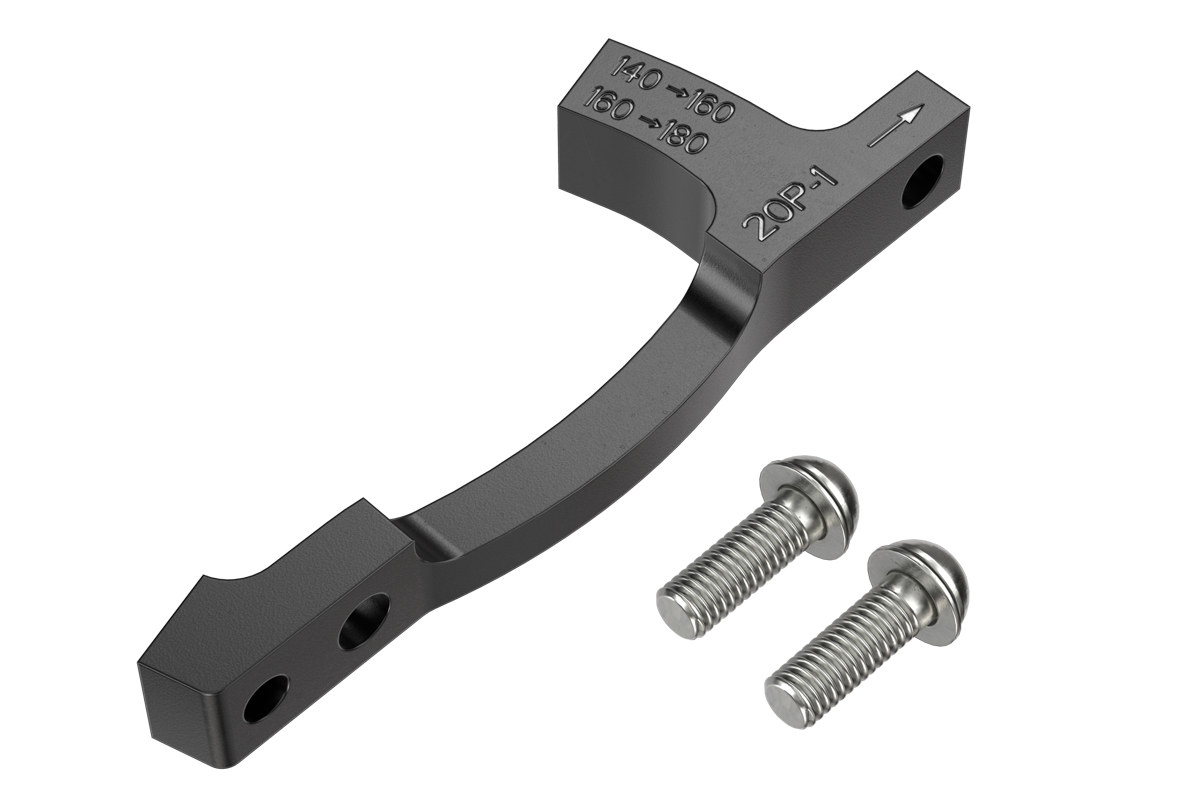
Brake post mount brackets are specific to the Mavens. Two sizes are available; The 20P-1 bracket works for 160/180mm rotors, and the 20P-2 fits 200/220mm. No conical hardware is required with these brackets, and four stainless steel mounting bolts are included.
Weights:
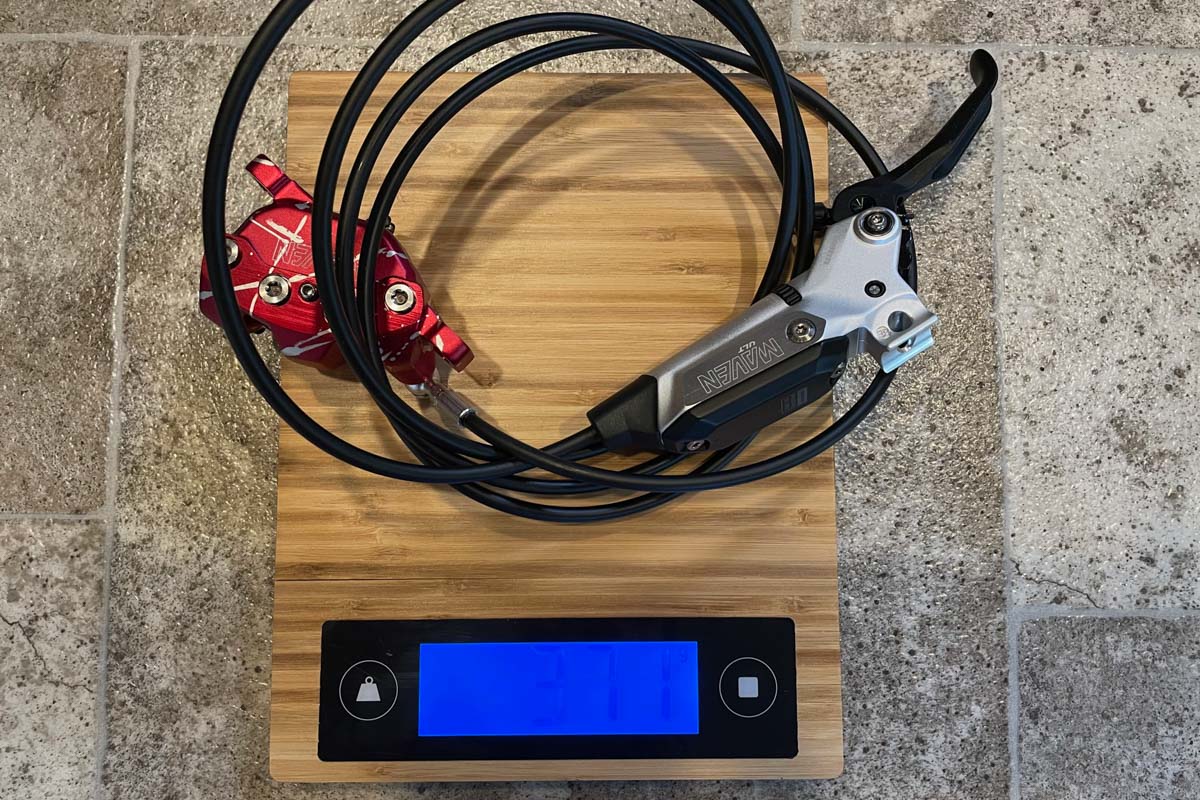
SRAM did provide weights for the Mavens: They list 362g for the Ultimate model, 371g for Silver, and 369g for Bronze (that’s the rear brake with pads, lever, and an 1800mm hose). My scale showed the Ultimates coming in slightly higher than claimed, at 350g for the front and 371g for the rear. Obviously, these are not an ideal brake for weight weenies, but they’re not significantly heavier than Codes.
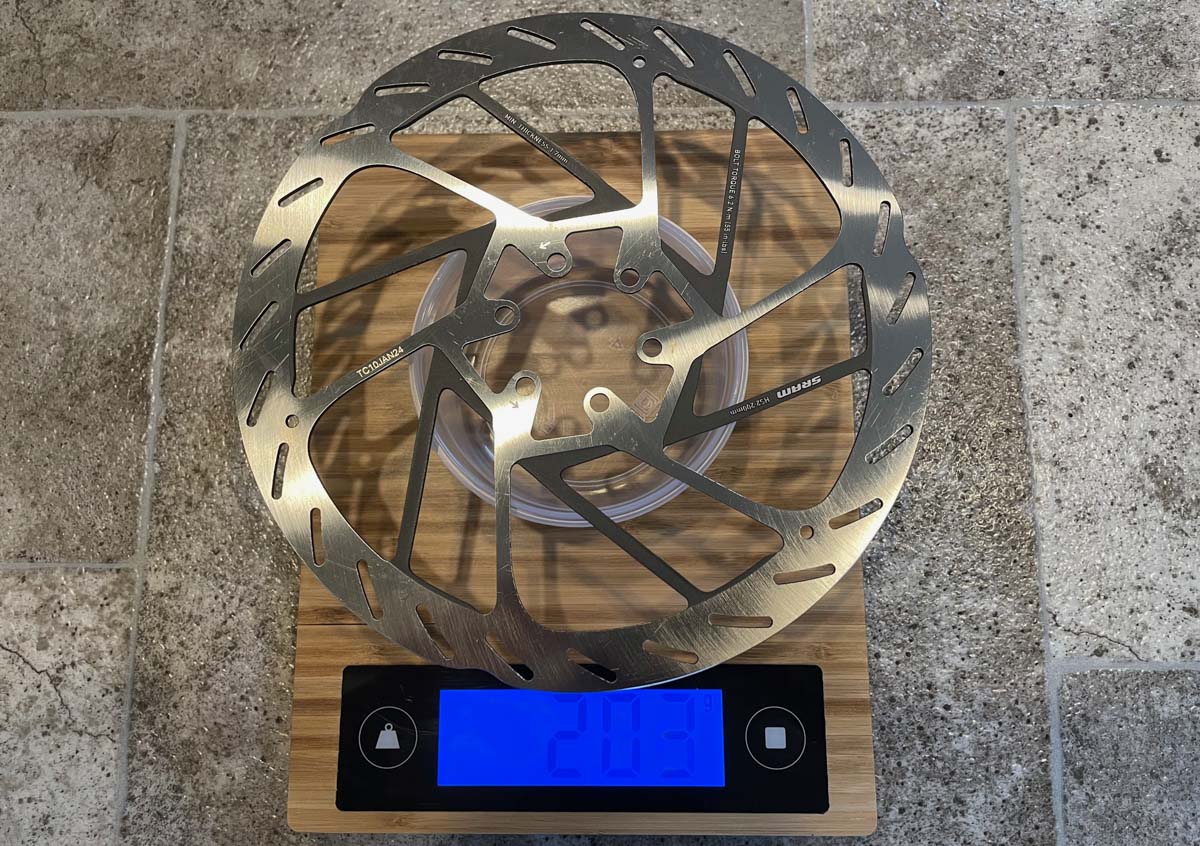
The HS2 rotors come in at 171g/180mm, 203g/200mm, and 270g/220mm. Each matchmaker handlebar clamp weighs 28g.
Bleeding:
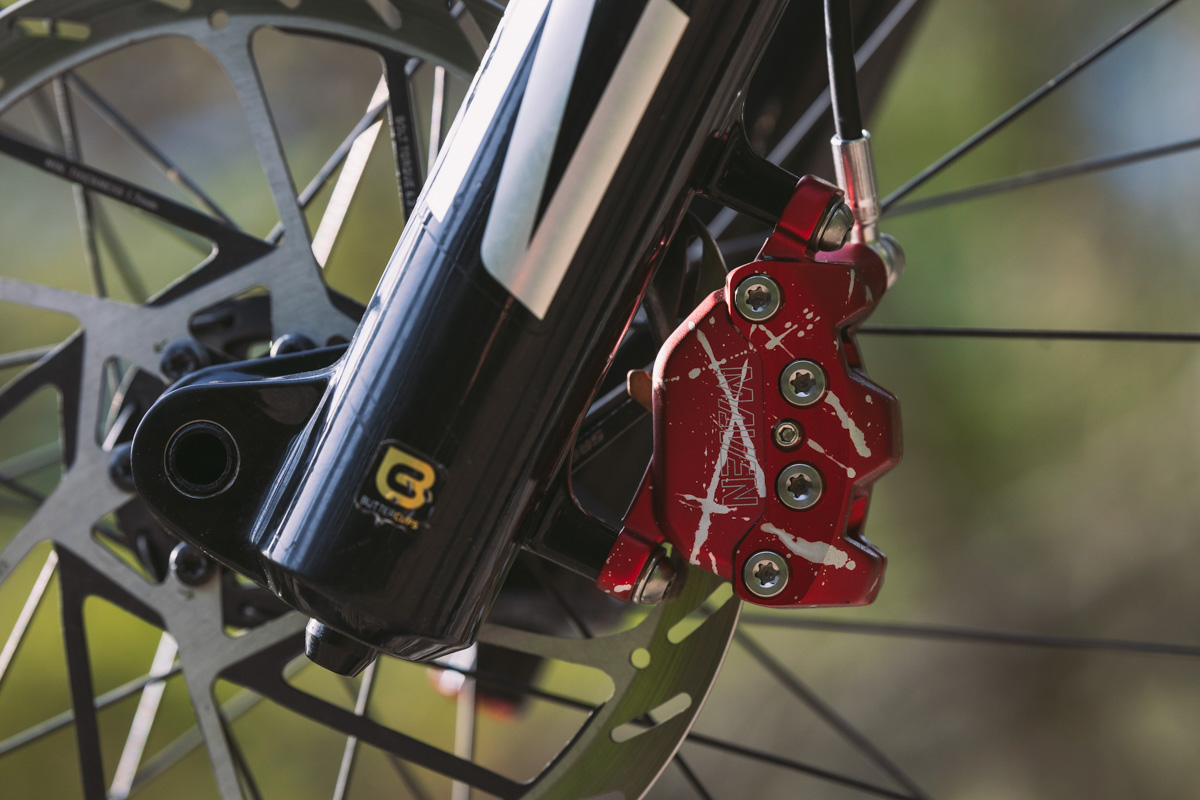
While bleeding the Mavens is mostly a standard job, there is one unique part to the process – massaging the caliper pistons. In simplified terms, once the system has been filled and bled there is one extra step of pumping the pistons in and out over the thin side of the pad spacer, and then pushing them back out before installing your wheel.
Model Lineup:
There are three models of the Maven brakes, and an option to buy the Ultimate model with an Expert Kit that includes everything you need plus a few extras. Below are some key differences between the models.
Maven Ultimate Expert Kit – $599
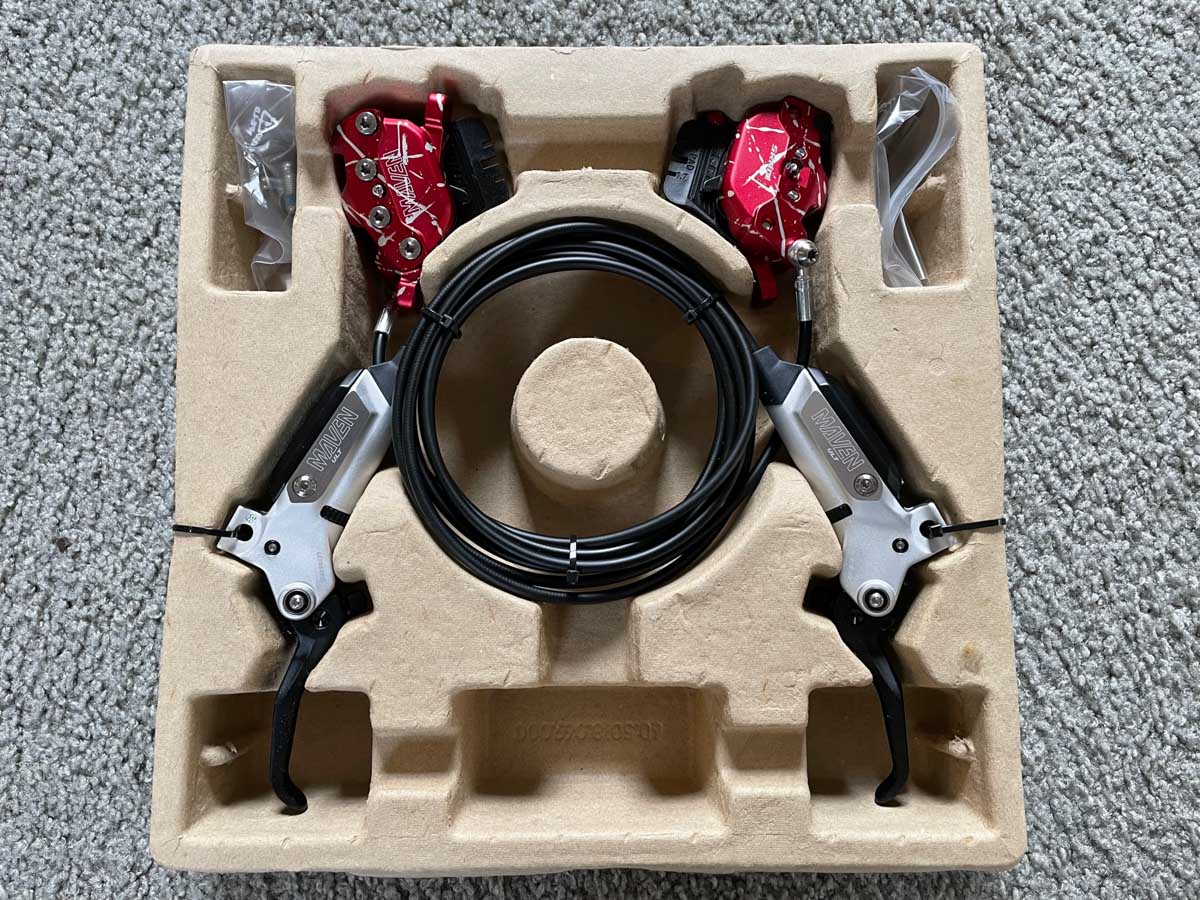
The very deluxe Maven Ultimate Expert Kit is a limited run, introductory package deal that anyone considering the Maven Ultimates should definitely jump on! For the same price as a front/rear combo of Maven Ultimates, the Expert Kit gives you a ton of extra parts so you can fine-tune the brakes to your needs, or for different race tracks. Once these kits sell out, they’re gone.
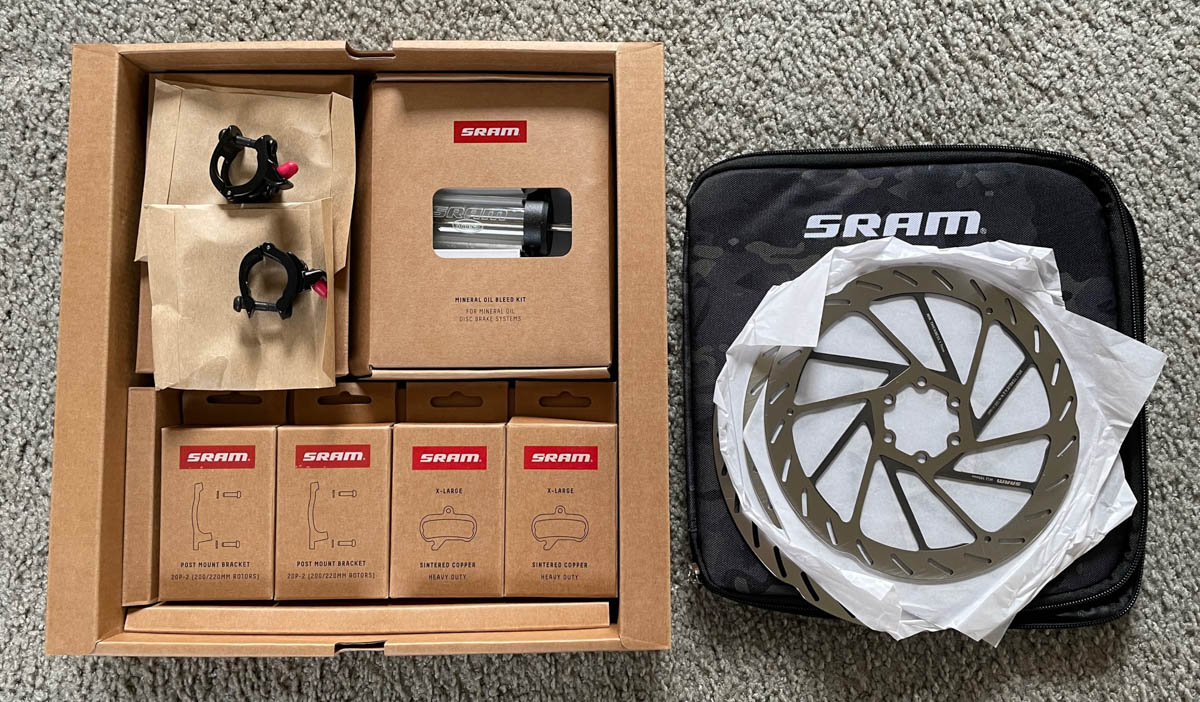
The Expert Kit includes both levers and calipers, four HS2 rotors (180/200/200/220mm) in a zippered carrying case, rotor bolts, two MMX clamps, two 20P-2 post mount brackets, two sets of sintered brake pads, a set of pre-installed organic pads, and a Pro Bleed Kit that includes Maxima mineral oil, four barbs and four olives.
Key specs on the Maven Ultimate brake include Ti caliper bolts and Ti lever bolts, and if you can get the Expert Kit you’ll get polished lever bodies. Last but not least, the calipers in the Ultimate Expert Kit come in a unique red splash anodized finish.
Maven Ultimate – $300

For the Ultimate, Silver, and Bronze models SRAM lists pricing for one brake (front or rear). All models include the caliper and lever, hose, a 20P-2 post mount bracket with bolts, a barb, an olive, and a matchmaker clamp. Rear brake kits include a Bleeding Edge fitting.
The Ultimate model gets Ti caliper and lever bolts. The calipers come in a clear anodized finish.
Maven Silver – $265

The Maven Silver steps down to stainless steel caliper and lever bolts, and the calipers are anodized in Bold Black.
Maven Bronze – $185
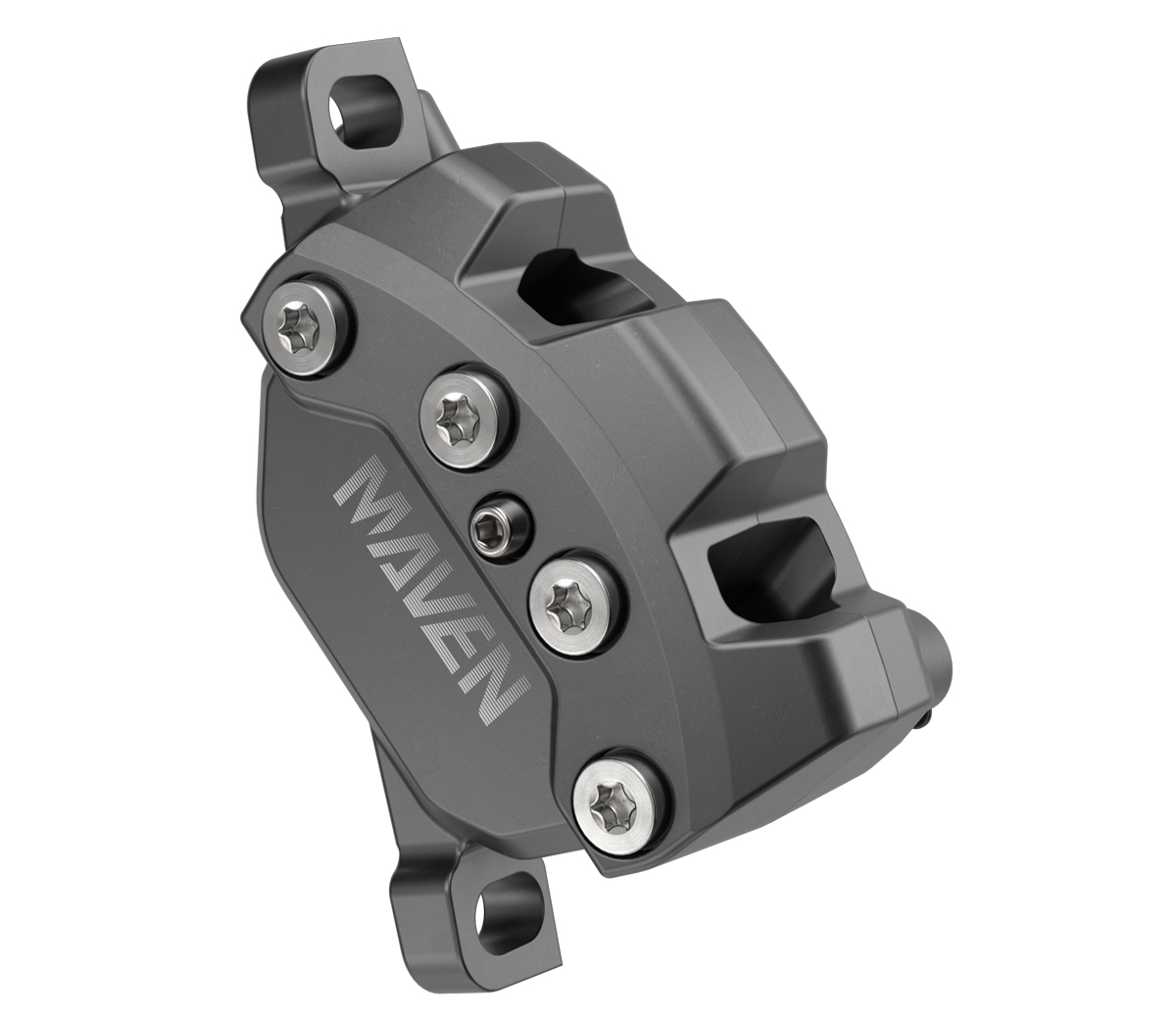
The Maven Bronze features the same size pistons, Bleeding Edge bleed ports, and tool-free reach adjust levers as the higher-end models, but there are some differences.
The bronze models use stamped aluminum caliper bodies, whereas higher-end models are all forged aluminum. They also get stainless steel hardware, and a bushing lever pivot instead of a bearing. There is no contact point adjustment on the bronze levers, and the calipers are anodized in Dark Polar.
When it’s time for replacements, XL organic or sintered brake pads both sell for $27.
The Maven brakes will be available at SRAM retailers this month.
Initial Impressions: Set up
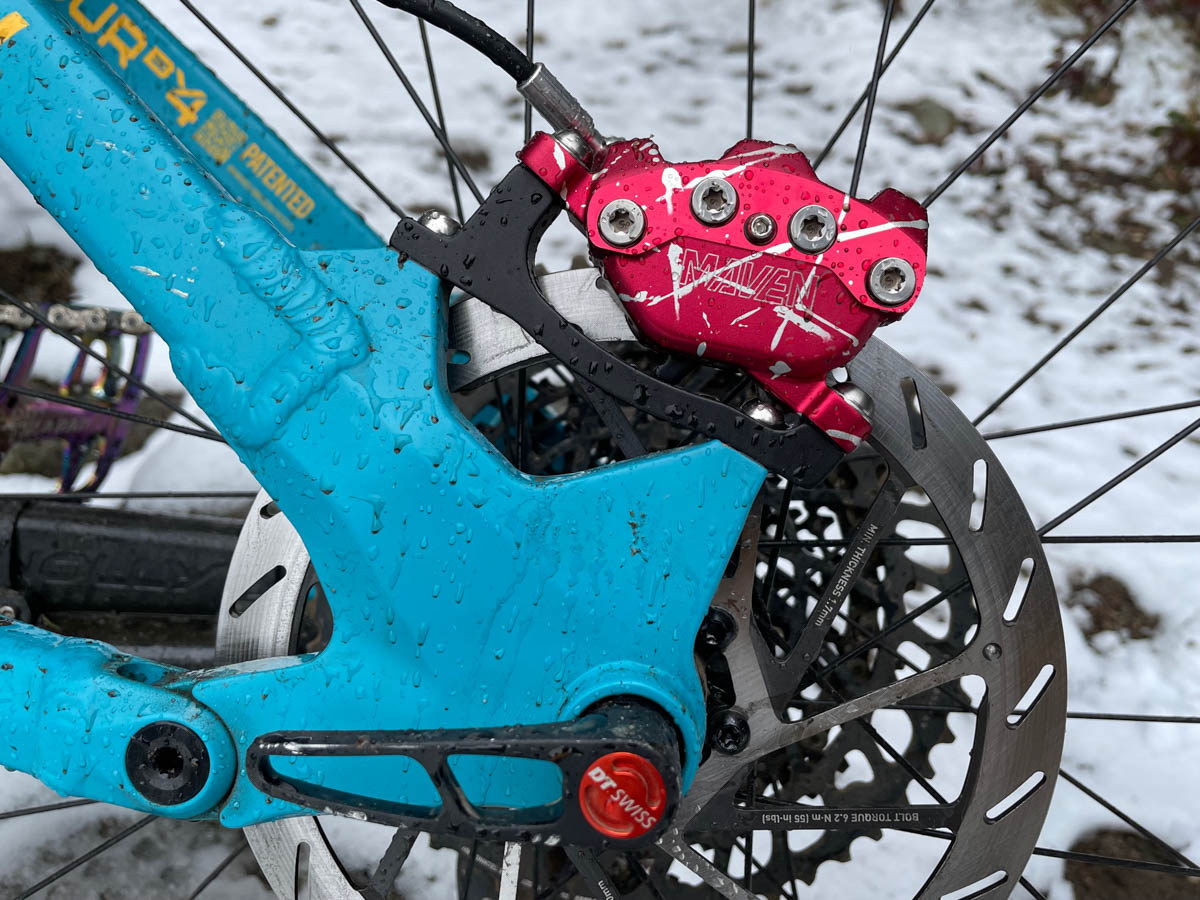
For initial setup, SRAM recommends starting with the smallest rotors your bike can run! I could actually put a 160mm rear rotor on my bike, but my local trails can get pretty steep so I stuck with two 180mm rotors.
I’m not a heavy guy, and I was putting the brakes on my non-electric enduro bike. Anticipating what the Maven Ultimates are capable of, SRAM’s North American PR agent Chris Mandell suggested I start with 180mm rotors and the organic brake pads.
Due to slippery, snowy conditions, my first test ride was just a chance to start bedding in the pads. On snowy trails, it was hard to get a feel for new brakes, but I noticed an obvious initial bite and it didn’t take much more of a squeeze to lock up a wheel.
On-Trail Performance:

My next couple of rides were better for testing, as I was mostly on damp dirt. I noticed much less effort squeezing the levers versus any other brake. The Mavens have a solid initial bite and the power comes on quickly. As soon as the pads touch the rotors you feel braking power, but you won’t just lock up your wheels. Beyond that, it only takes a slight squeeze to ramp up ample power for most brake taps into corners, etc. The only time you have to put out anything close to the effort most brakes require is on steep descents or high-speed sections.
Some of my trails are still slippery and the Spring dirt is a bit slick, so I’m still having some issues with locking up the rear wheel. Feathering the Mavens does take some getting used to; you really do need to lighten up your touch on the lever for light and mid-level braking, or the Maven’s power can come on too strong. Even on dirt sections of trail, I locked up the rear a few times when I didn’t intend to. I expect with a few more rides I’ll adapt to the lighter touch needed.

As for the levers I like how SRAM stuck with their established shape. Aside from squeezing them more gently, the Maven levers will offer a familiar feel to anyone who runs SRAM brakes. Also, the matchmaker clamps left my dropper post remote and shifter in comfortable positions.
With only a few rides so far, I’ll dive deeper into long-term performance and fine-tuning in a full review later this summer… stay tuned to Bikerumor!

